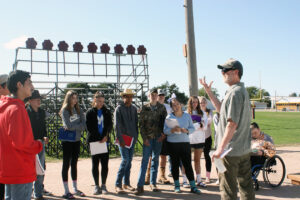December 1, 2021
California and Colorado: Artist Workforce Initiatives
The COVID-19 pandemic caused significant income losses for independent artists and creative workers, especially those reliant on gigs and contractual jobs. This trend is concerning not only because of the hardship it caused for these workers and their families, but also because the creative economy relies on the robust production and engagement of artists across many different artistic disciplines and industry clusters—and the creative economy can, in turn, be a catalyst for broader economic recovery as the nation emerges from the pandemic. To address this issue, both California and Colorado launched artist workforce programs in fall 2021. While the two states used different funding sources and grant mechanisms, both are intended to put artists to work while helping communities address timely social issues and public health needs.
California Creative Corps

Teaching artist Miles Lewis and 11:11 A Creative Collective work with community members on the “Oak Tenders” mural, part of a project to explore art making and environmental and human health.
The California Arts Council (CAC) is launching a new California Creative Corps pilot program. Supported through $60 million in one-time general fund money, this two-year workforce development program will demonstrate the transformative role that artists can play in facilitating community resilience and recovery. The initiative is a multifaceted grant-making, media outreach and engagement campaign designed to employ artists to:
- raise awareness of public health issues and stop the spread of COVID-19,
- educate the public about energy conservation, water conservation, climate mitigation, and emergency readiness and recovery, and
- engage residents around timely issues that affect communities, including election participation and social justice.
Competitive awards will go to local, regional and statewide arts organizations that demonstrate strong engagement with Black, Indigenous and/or people of color (BIPOC) populations. Grant guideline development will begin with the convening of a California Creative Corps Program Development Community Panel. The panel will include artists, culture bearers, creative individuals and/or arts administrators who represent the priority populations to be engaged; representatives from other state departments and agencies engaged in public health activities; individual artists that are already working at the intersection of arts and wellness, the environment, election participation, and social justice; and potential funding partners.
Funds will be regranted to artists and culture bearers for community based activities. The initiative will encompass broad geographic reach across California’s 58 counties while prioritizing areas that demonstrate the highest levels of need as indicated by the California Healthy Places Index, a suite of indicators that track environmental, educational, economic, housing and health conditions and life expectancy risk factors. CAC is developing a set of qualitative and quantitative metrics to track the outcomes of community projects conducted under the auspices of the Creative Corps initiative. Learn more.

Artist Gregory Hill works with participants of the Grassroots Community Center Prairie Writer’s Workshop in Joes, Colorado.
Colorado Creative Corps ARP Grant
The state of Colorado has dedicated $500,000 in National Endowment for the Arts American Rescue Plan (ARP) funds to a new effort to boost employment opportunities for artists. Led by Colorado Creative Industries (CCI), the Colorado Creative Corps ARP Grant is modeled after the Works Progress Administration’s Federal Art Project that responded to the Great Depression of the 1930s. The new initiative will create jobs for artists affected by COVID-19 and deepen relationships between artists and communities to help to sustain Colorado’s creative sector. Awards of $2,500 to $25,000 will be paid directly to artists to undertake creative projects that address local priorities such as youth mental health, suicide prevention, food justice, prison reform, youth at risk and healthy communities. Some factors considered in application adjudication will include:
- artistic excellence of the proposed project, including inclusion of underserved populations, meaningful participant experiences, and high accomplishment and skill “within the cultural context of the presented project”;
- alignment of the proposed project with community needs, and public engagement in the project’s design and/or execution; and
- collaboration with local cross-sector partners.
As appropriate, applicants are encouraged to note how they will engage with constituencies identified by White House executive orders (i.e., historically Black colleges and universities, tribal colleges and universities, American Indian and Alaska Native tribes, African American serving institutions, Hispanic serving institutions, Asian American and Pacific Islander communities, and organizations that support the independence and lifelong inclusion of people with disabilities). Grantees will need to report data on community impact, number of creative workers employed and hours of paid artist work. For more information on the Colorado Creative Corps ARP Grant, contact CCI Program Manager Libby Barbee.
In this Issue
From the President and CEO
State to State
Legislative Update
The Research Digest
Announcements and Resources
More Notes from NASAA
SubscribeSubscribe
×
To receive information regarding updates to our newslettter. Please fill out the form below.

